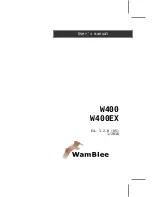
5
Y1-03-0222 Rev. C
On the bottom, a typical N
auticast™-B AIS installation in a common environment is shown. The Nauticast™-B
AIS is connected to the vessel
‟s power supply, and, in connection with the VHF and GPS antennas, the minimal
requirements for transponder operation are fulfilled.
Both vessels in the above illustration are equipped with an AIS transceiver
. Due to “Time – Synchronization”,
they use the same organization of free and allocated windows (slots) in the shared VHF Data Link (this method
is called “Carrier Sense Time Division Multiple Access”) to send and receive messages. Without the necessity of
any operator interaction, both vessels know exactly who or what is cruising nearby and where the individual
object is heading.
The scenario below shows a full AIS coverage area (including all applications and complete shore
infrastructure).
2.
AIS classes
There are two classes of AIS units fitted to vessels, Class A and Class B. In addition, AIS base stations may be
employed by the Coast Guard, port authorities and other authorized bodies. AIS units acting as Aids to
Navigation (A to N) can also be fitted to fixed and floating navigation markers such as channel markers and
buoys.
Class A units are a mandatory fit under the Safety of Life at Sea (SOLAS) convention to vessels above 300
gross tons, or which carry more than 11 passengers in international waters. Many other commercial vessels and
some leisure craft also may be fitted with Class A units.
Class B units are designed for fitting in vessels which do not fall into the mandatory Class A fit category.
The
ACR N
auticast™-B Automatic Identification System is a Class B AIS unit.
Summary of Contents for AIS-B - REV C
Page 1: ......





















